Shades That Block Out All Light: An In-Depth Review
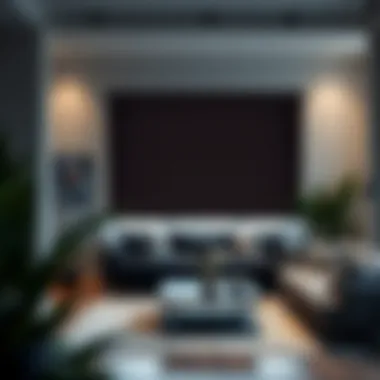
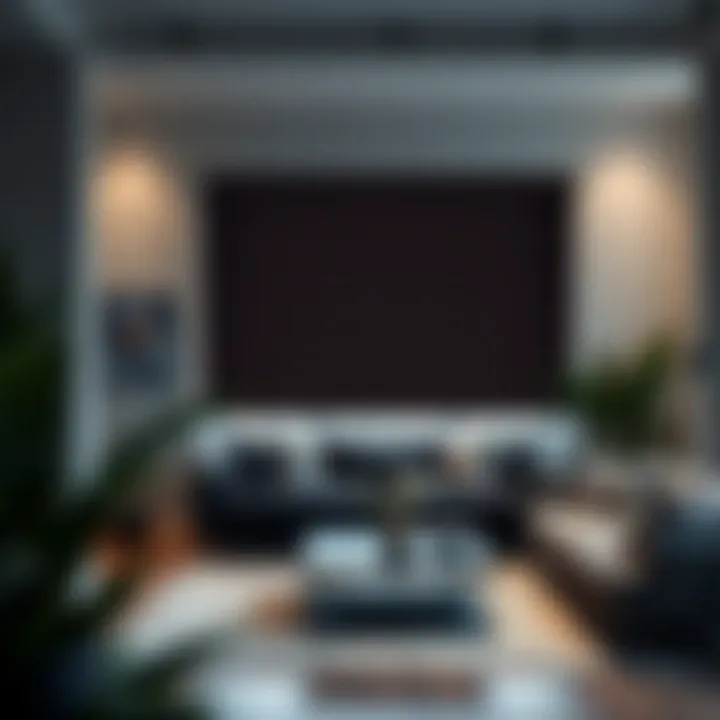
Intro
In today’s fast-paced lifestyle, having control over light and ambiance in your living spaces can make a world of difference. Whether you want to keep the sunlight at bay during the day or create a cozy atmosphere during the evening, blackout shades offer a multifaceted solution. These shades have transformed the way we perceive light within our homes and workplaces, marrying functionality with style. This guide dives deep into the intricacies of blackout shades, from material choices to installation methods and their broader implications on energy efficiency.
Consider this: when you are trying to create the perfect environment for relaxation, sleep, or productivity, controlling light is paramount. Blackout shades don’t just block out light—they also help regulate temperature, reduce noise and improve privacy. With numerous styles and designs, they can complement nearly every interior theme. In this comprehensive exploration, we aim to enlighten homeowners, designers, and DIY enthusiasts on the nuances of blackout shades, ensuring that each decision is well-informed and tailored to individual needs.
Furniture Design Trends
Current Styles and Aesthetics
The world of interior design constantly evolves, with trends that reflect both functionality and visual appeal. When it comes to blackout shades, there’s no shortage of styles that align with popular aesthetics. Modern homes often embrace minimalism, favoring clean lines and simplicity. The shades in these spaces tend to feature solid colors or subtle patterns that blend seamlessly with the environment.
On the other end of the spectrum, bohemian and eclectic designs make room for vibrant and textured fabrics. These may include layered blackout shades paired with sheer curtains to create depth and visual interest. Customization is key; some homeowners prefer to incorporate printed blackout shades that echo elements found in their furniture or wall colors, thus weaving a cohesive narrative throughout their spaces.
Color Palettes and Materials
The choice of color and material can have a significant impact on the overall aesthetic of a room. Most people lean towards neutral tones, as they provide versatility and a sense of calm. Shades in shades of gray, beige, or soft pastels can be incredibly soothing, making them an excellent option for bedrooms.
However, don’t shy away from bold colors if you are looking to make a statement. Deep blues, rich reds, or even bright yellows can inject personality into a room, particularly when paired with carefully chosen furnishings. Materials also play a key role. Common options include polyester, which is budget-friendly and durable, and more luxurious choices like velvet for an opulent feel.
When considering blackout shades, it’s important to think about the ambiance you are creating; the right color and material can illuminate or calm a room's vibe exponentially. Keep in mind that some materials are not only about looks but also about performance. For example, reflective materials can further enhance thermal efficiency.
"Blackout shades are not merely an afterthought; they should be an integral part of your design narrative."
As you choose your blackout shades, reflect on how they work with your existing furniture and decor rather than standing apart from them.
Buying Guides
Essential Considerations When Purchasing
Before adding blackout shades to your home, it’s crucial to consider a few key factors. The first is size—ensure to measure your windows accurately to prevent any misfits. Depending on your preferences, you might want shades that fit snugly inside the window frame or those that cover the entire area for a more dramatic effect.
Material quality must also come into play. Opt for fabrics with high opacity if complete darkness is a priority. Additionally, you might find additional features such as light-blocking liners, which can enhance their effectiveness.
- Here are some more considerations to keep in mind:
- Installation Method: DIY installation versus professional help.
- Budget: Balance between quality and affordability.
- Energy Efficiency: Look for shades that offer insulation benefits.
Top Recommendations for Different Budgets
Finding the perfect blackout shades doesn’t have to break the bank. For a budget-friendly option, the IKEA FYRTUR shades provide good light-blocking capabilities without compromising on style.
For those willing to spend a little more, Hunter Douglas Duette shades are praised for their energy-efficient designs and customizable options, making them suitable for a wide array of rooms.
Finally, luxury options such as Lutron Serena shades epitomize technology and aesthetics, equipped with smart home compatibility for a seamless living experience.
For more resources, check out Wikipedia on Window Treatments and Britannica's Guide to Interior Design.
Understanding Blackout Shades
The world of blackout shades goes beyond mere window coverings; they stand as crucial players in the intersection of functionality, privacy, and design. Their significance becomes evident when considering how they can transform spaces. In homes or commercial settings, these shades serve more than a decorative role—they possess the ability to control light and ambience. The importance of understanding blackout shades lies in recognizing their capacity to create versatile environments, tailored to personal needs and comfort.
Definition and Purpose
Blackout shades are specially designed window treatments that block out virtually all light when drawn. Unlike standard curtains or blinds, which may allow some light to seep through due to gaps or fabric translucency, blackout shades offer a complete shield against external brightness. Their main purpose is to control light levels, making them an ideal choice for bedrooms, home theaters, and workplaces where glare reduction is necessary. These shades can also contribute to energy savings by providing thermal insulation, keeping spaces cooler in the summer and warmer during winter months.
Equally important is their role in privacy enhancement. In urban settings, where high-rise buildings loom close, blackout shades create a haven from prying eyes. This can significantly enhance the sense of security and seclusion, allowing occupants to enjoy their spaces without the worry of onlookers or bright streetlights disrupting their comfort.
Additionally, they serve aesthetic purposes as well, coming in various designs and colors that complement interior decor. Homeowners and designers alike can select shades that align with the style of the space, adding a touch of sophistication while achieving functional goals.
History of Light Blocking Solutions
The journey of light-blocking solutions is a narrative intertwined with human needs for comfort and primal instinct for safety. Before technological advancements introduced modern blackout shades, individuals employed various methods to shield their living environments from light. In ancient times, people relied on heavy fabric drapes and animal skins to diminish sunlight. These rudimentary solutions, although effective to a degree, were often cumbersome and lacked versatility.
The invention of mechanical window treatments in the 19th century marked a pivotal point in light control. With the advent of roller shades and curtains made from thicker, darker materials, light blocking became more efficient. The idea that window treatments could effectively block out distracting light during specific hours sparked innovation, driving manufacturers to refine designs for improved functionality and style.
As society progressed into the 20th century, the demand for enhanced comfort and the rise of urban living led to further developments. The realization that deep sleep and relaxation depended on darkness encouraged consumers to seek out products that would address these needs. This trend laid the foundation for the modern blackout shades we are familiar with today.
In recent decades, with the focus on energy efficiency and environmental sustainability growing, manufacturers have introduced fabrics that not only block light but also insulate against outdoor temperatures. This synthesis of function and intention speaks to society's evolving relationship with light and energy conservation.
Understanding the evolution of blackout shades is vital for homeowners and designers, as it sheds light on why these products are more than just a trendy décor choice. They encapsulate a historical journey toward comfort and efficiency.
Types of Blackout Shades
In the realm of window treatments, blackout shades are a game changer. They provide more than just aesthetics; they serve practical purposes too. Understanding the different types of blackout shades can help homeowners, designers, and DIY enthusiasts select the best option for their specific needs. Each type exhibits unique features that cater to light control, energy efficiency, and personal style preferences.
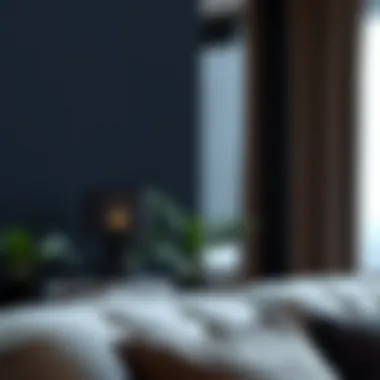
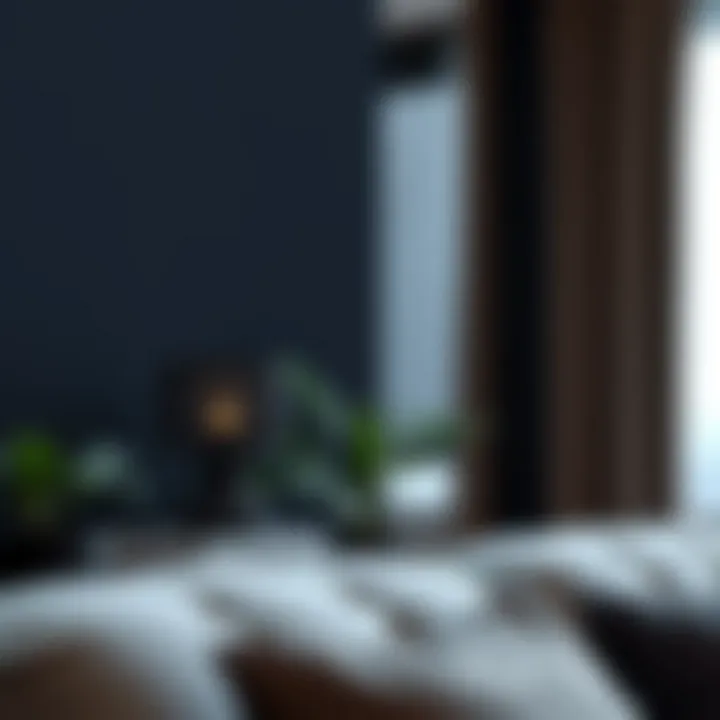
Fabric-Based Shades
Blackout Liners
Blackout liners are a popular choice for many homeowners who seek simplicity without compromising on functionality. They are typically used in conjunction with existing shades or curtains, providing an extra layer of fabric that blocks out almost all light. The key characteristic of blackout liners is their ability to reduce light infiltration effectively. This makes them a beneficial option for bedrooms or media rooms where a complete darkness is desired at night.
The unique feature of blackout liners lies in their versatility. They can be added to various types of shades, giving the homeowner flexibility in style and decor. However, they can be more challenging to clean and maintain, as they often require dry cleaning to keep them looking fresh.
Thermal Fabrics
Thermal fabrics take blackout shades a step further, offering not just darkness but also temperature control. These shades are crafted with insulating properties that help regulate indoor temperatures, enhancing energy efficiency. This feature is particularly advantageous in areas with extreme weather conditions.
One unique aspect of thermal fabrics is their dual function; they provide both light blocking and insulation. While they are advantageous in energy savings, they can sometimes be thicker, making them less suitable for every decor style.
Roller Shades
Manual vs. Motorized
When it comes to roller shades, there’s a decision to be made: manual or motorized. Manual roller shades are straightforward and often more cost-effective. They usually operate through a pull mechanism that allows for easy adjustment. This simplicity makes them a popular choice among budget-conscious homeowners.
Motorized roller shades, on the other hand, offer convenience and modernity. Automated systems can be controlled via remote or even smartphone apps, providing an ease-of-use that manual shades can't match. An example of their unique feature is the ability to set schedules for open and close times, which can heighten security and energy savings. However, they come with a higher price point and require a power source, making installation a bit more complex.
Customization Options
Customization options for roller shades allow homeowners to tailor shades according to their personal preferences. This can range from size and color to fabric type and pattern. This flexibility ensures that shades not only serve their practical purpose but also align with the overall interior design of a space.
The unique feature here is the variety of looks one can achieve, from sleek and modern to cozy and traditional. Yet, customization may require more time and effort during the ordering process, a consideration for those in a hurry.
Roman Shades
Roman shades provide a classic touch to any room while ensuring functionality. When raised, they fold neatly, adding a decorative element even when not in use. Their design can feature various fabrics and patterns, allowing for personalization while offering excellent light-blocking capabilities.
Cellular Shades
Energy Efficiency
Cellular shades are designed with pockets that trap air, making them highly energy-efficient. This design minimizes heat loss during winter and keeps spaces cool in summer. The energy efficiency of these shades is a crucial benefit for eco-conscious homeowners, providing comfort while reducing energy bills.
Light Control
Light control is another vital aspect of cellular shades. They can be adjusted to allow varying amounts of light to filter in while still blocking out harmful UV rays. This feature offers flexibility since it can enhance room ambiance throughout the day and at night.
While cellular shades offer numerous advantages, such as energy savings and diverse light control options, cleaning them can pose a challenge due to their design. This balancing act is essential for homeowners considering this shade type.
"Opt for shades that suit your needs, as the right choice can enhance both comfort and aesthetics in your home."
In summary, understanding the different types of blackout shades not only ensures effective light control but also allows for greater versatility and personalization in interior spaces. Selecting the right type entails weighing the features, potential benefits, and personal preferences.
Materials for Blackout Shades
When it comes to blackout shades, the choice of material plays a pivotal role in their overall effectiveness and aesthetics. The right material not only blocks out light but can also influence energy efficiency, ease of maintenance, and even the ambiance of a room. By understanding the characteristics of various materials, homeowners, designers, and DIY enthusiasts can make informed decisions that meet their needs and preferences.
Common Fabric Types
Polyester
Polyester is a widely recognized choice for blackout shades. Its key characteristic is durability; it withstands wear and tear better than many other fabric types. This strength gives it a notable edge, especially in homes with pets or children, ensuring the shades maintain their appeal over time.
Additionally, polyester does an excellent job at blocking unwanted light, making it an ideal material for those aiming for complete darkness.
One unique feature of polyester is its resistance to wrinkling and shrinking. Homeowners often appreciate this aspect as it means their shades will look sharp without frequent ironing or adjustments. However, a downside can be its tendency to retain heat, so if a blackout shade is installed in a sun-drenched room, it may not provide the cooling effect that natural fabrics could.
Cotton Blends
Cotton blends offer another strong option when it comes to blackout shades. The presence of cotton in the blend brings breathability and softness, making these shades much more inviting to touch and look at. This softness can enhance the overall decor, merging functionality with aesthetic appeal seamlessly.
What makes cotton blends particularly beneficial is their ability to be more environmentally friendly than purely synthetic options. Many manufacturers now produce these blends using sustainable practices, which resonate with eco-conscious consumers. However, while cotton blends are fantastic for blocking light, they may require more maintenance than synthetic materials, needing regular cleaning to avoid fading.
Innovative Textiles
Eco-Friendly Options
Eco-friendly options are emerging as essential contributors in the realm of blackout shades. Design that caters to sustainability is no longer just a trend; it represents a shift in consumer expectations for quality and responsibility. These fabrics are typically made from recycled materials or sustainable fibers, reducing environmental impact significantly.
One of the attractions of eco-friendly options is their low volatile organic compound (VOC) emissions, which contributes to better indoor air quality. Moreover, they often maintain excellent heat retention properties, making them not just an environmentally sound choice but also advantageous for energy efficiency in residential and commercial settings. A hurdle, though, is that they might carry a higher price tag compared to conventional fabrics, but many believe the long-term benefits justify the investment.
Fire-Resistant Fabrics
Fire-resistant fabrics are crucial in specific settings, particularly in commercial spaces like theaters and offices. Their inherent design minimizes the risk of flame spread, thus enhancing safety in environments where fire hazards are a concern.


These materials' key characteristic is their ability to self-extinguish or resist ignition when exposed to flames, substantially contributing to overall building safety standards. Using fire-resistant materials can also add to peace of mind for homeowners wanting an extra layer of security. Nevertheless, a drawback would be that some of these fabrics may lack the aesthetic qualities or customization features of standard blackout options, which can limit their appeal for some users.
In summary, the material selection for blackout shades is far from straightforward, requiring careful consideration of various factors from light-blocking capabilities to ease of maintenance and safety features. This holistic understanding aids in ensuring a well-rounded approach to both functionality and design in any living space.
Benefits of Blackout Shades
When it comes to enhancing the functionality of a living space, the benefits of blackout shades cannot be overstated. They play a critical role in providing comfort, enhancing privacy, and even contributing to energy efficiency. Understanding these layers of benefits equips homeowners, designers, and DIY enthusiasts with knowledge to make informed choices.
Light Control
One of the standout features of blackout shades is their ability to control light. With these shades, you can easily transform a sun-drenched room into a sanctuary of darkness. When opting for blackout shades, you gain the power to block out 100% of the light when needed. This feature is especially crucial for night shift workers or anyone who struggles to sleep during the day. Moreover, their ability to darken a room extends beyond just sleep; it creates an optimal environment for watching movies or working without distractions from glare.
Privacy Enhancement
Privacy often goes unnoticed until it's compromised. Blackout shades provide a solid solution for those looking to shield their indoor lives from prying eyes. By effectively preventing outside view, they allow you to enjoy peace of mind in your home. Whether it’s a busy street or a neighboring property, blackout shades create a secure enclosure. This feature is particularly beneficial in urban settings where noise and visibility are higher, giving homeowners the confidence to engage in daily activities without the worry of being seen.
Energy Savings
In today's world, being energy-conscious is more than just wise; it’s essential. Blackout shades contribute to energy savings by acting as insulators. During the cold months, these shades trap warmth inside, preventing heat loss. Conversely, in summer, they help keep your house cooler by blocking outside heat. As a result, shorter reliance on heating and cooling systems can lead to noticeable savings in energy bills. This not only positively impacts your wallet but also reduces your carbon footprint, making it a win-win situation for the environmentally conscious homeowner.
Aesthetic Value
The aesthetic value of blackout shades adds yet another layer of appeal. They don’t only serve functional purposes, but they also come in various designs and colors that enhance the overall interior design of a space. Homeowners can choose shades that match their decor, from minimalist designs to rich textures, offering versatile style options that suit any room.
Integration with Interior Design
Integrating blackout shades into your interior design scheme is essential for achieving a polished look. This process involves selecting shades that complement existing furnishings and color palettes. The key characteristic of this integration lies in its ability to unify different elements of a room. For example, a soft-toned fabric can balance darker furniture, creating a sense of harmony. Additionally, well-chosen blackout shades can accentuate room features, drawing the eye while maintaining functionality.
However, it’s important to consider how the shades will work with window sizes and placements. A unique feature of blackout shades is that they can be customized, allowing for measurements that perfectly fit your windows. While this option can incur a higher cost, the advantages in both aesthetics and function often outweigh the initial investment.
Installation and Maintenance
Installation and maintenance of blackout shades play a crucial role in maximizing their benefits. Getting this part right can make all the difference, not just in functionality but also in aesthetics and long-term satisfaction. Blackout shades, designed primarily to block light, require proper installation to achieve their intended purpose effectively. Moreover, the way one takes care of these shades can impact their durability and appearance.
Professional vs. DIY Installation
When it comes to installing blackout shades, homeowners often find themselves at a crossroads: hire a professional or tackle the project themselves. Each approach has its pros and cons, and weighing them carefully can be vital.
Hiring a Professional
Choosing a professional installer can save time and reduce the likelihood of mistakes. Professionals possess the skills and experience to handle various window types and can recommend the best mounting methods. Additionally, they might offer an installation guarantee, providing peace of mind if anything goes awry.
DIY Installation
On the other hand, opting for a DIY installation can be an empowering experience. It allows homeowners to take control of their space and can save money—but it’s not without challenges. A successful DIY installation requires basic tools and knowledge of the specific product. Clear instructions are usually provided with the shades, and online tutorials can guide the process. Homeowners must assess their comfort level with tools and their ability to measure accurately.
Cleaning and Care
Taking care of blackout shades is as important as installing them properly. Regular cleaning not only maintains their appearance but can also prolong their lifespan. Here are a few key tips to keep in mind:
- Dusting: A simple dusting using a microfiber cloth or a vacuum with a brush attachment can prevent dust buildup.
- Spot Cleaning: For stains or marks, gently blot the area with a damp cloth. Avoid harsh chemicals that could compromise the fabric.
- Periodic Deep Cleaning: Depending on the material, deep cleaning might be necessary. Some fabrics are machine washable while others may require professional cleaning.
- Inspect for Damage: Regularly check for any signs of wear and tear. Catching issues early can save costs on repairs or replacement later.
To encapsulate, ensuring that proper installation and maintenance processes are in place not only heightens the functionality of blackout shades but also secures their aesthetic contribution to interiors. Balancing professional expertise with DIY efforts, along with a robust cleaning regimen, can reward homeowners with satisfaction and longevity in their investment.
Selecting the Right Shades
Choosing the right blackout shades is a decision that weighs heavily on both function and style. For homeowners, designers, and DIY enthusiasts, understanding personal needs and specific room characteristics can greatly influence this choice. Proper assessment not only enhances aesthetics but also ensures effective light blocking, energy efficiency, and privacy.
When it comes to selecting the right shades, several factors come into play:
- Personal lifestyle: Do you work night shifts and need complete darkness during the day? Or perhaps you have small children and want a peaceful nap environment?
- Aesthetic preferences: The look of the shades should complement the existing decor. Color, texture, and style are essential in creating a cohesive interior.
- Functionality requirements: Consider how often you'll operate the shades. Are you looking for a quick pull-down option or a more sophisticated motorized solution?
Each decision impacts not only the practical use of the shades but also the overall environment of the home or facility.
Assessing Personal Needs
Starting with personal needs is crucial. Individuals have different requirements based on their lifestyle and preferences. For instance, someone who values a dark environment for sleep might prioritize extreme light-blocking materials over decorative options. Those dealing with pervasive streetlight exposure or working flexible hours may also find that integrating blackout shades significantly improves their quality of life.
Room-Specific Considerations
As we move forward, the specific rooms within the house should not be treated equally. Different spaces have different demands.
Bedrooms
Bedrooms typically serve as sanctuaries for rest. Hence, one of the greatest aspects of bedroom blackout shades is their capacity to create a tranquil retreat. Many homeowners appreciate how these shades effectively block light, allowing for a deeper sleep, free from disturbances. A unique feature is the variety of styles, from sleek roller shades to fabric Roman shades, giving each room a personal touch. However, a disadvantage could be the potential for dust collection over time, requiring regular maintenance to ensure cleanliness.
Home Theaters
Home theaters are another room where blackout shades shine. Here, the primary focus is on creating an immersive viewing experience. These shades manage light to ensure no glare interferes with the screen, making them a popular choice for cinephiles. The unique feature here is the possibility of motorized options that allow for seamless operation with the press of a button, adding a touch of modern convenience. The downside? Depending on the chosen material, they might not offer the same level of thermal insulation, potentially impacting energy use during extended screenings.
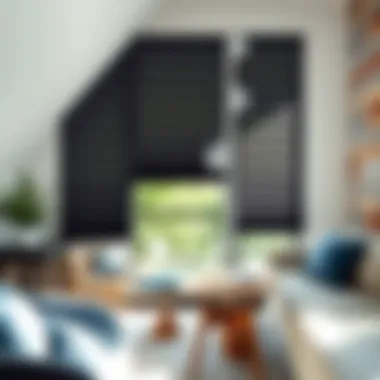
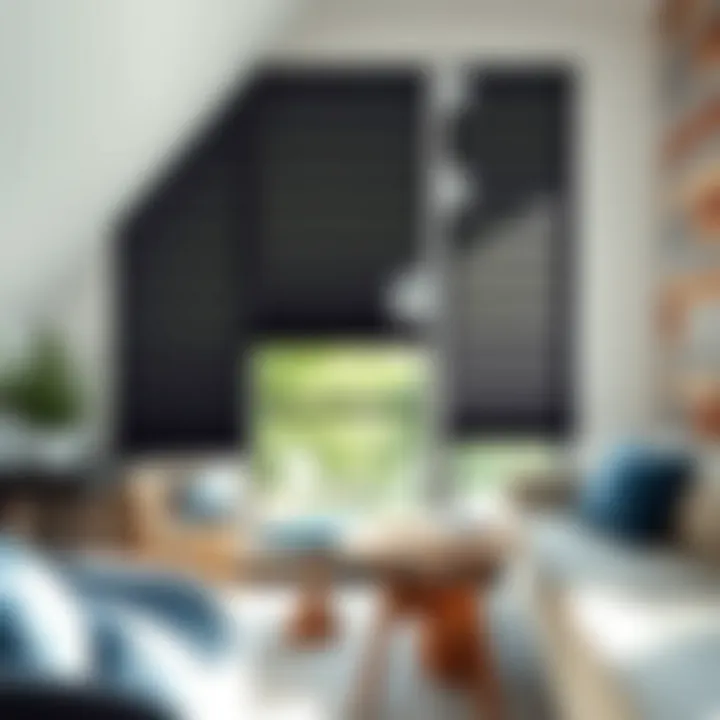
Window Specifications
Understanding your window specifications is fundamental when selecting shades. Window size, type, and placement all affect what kind of shades will provide the best fit. Custom sizes may be necessary, especially in uniquely shaped or sized windows. Moreover, knowing the direction the windows face can influence light levels throughout the day, guiding choices about the opacity of the fabric.
In summary, choosing the right shades is a multifaceted journey that requires thoughtful consideration of personal needs, room-specific requirements, and window specifications. By honing in on these aspects, homeowners can ensure they select shades that meet both their aesthetic desires and functional needs.
Trends in Blackout Shade Design
In an ever-evolving landscape of interior design, blackout shades are struting into the limelight with some modern twists. These advancements not only enhance functionality but add a layer of sophistication and style. As homeowners and designers seek out solutions that cater to contemporary needs, it's essential to understand the latest trends surrounding blackout shades. Two key aspects stand out: Smart Technology and Sustainability, both playing a pivotal role in the future of home decor.
Smart Technology Integration
As technology continues to intertwine with our daily lives, smart features in blackout shades have become a focal point for modern homes. Smart blackout shades are no longer just a luxury, but increasingly a necessity for those looking to elevate their living spaces. Features like remote control, smartphone compatibility, and integration with home automation systems enable users to operate shades with a simple tap or voice command.
Imagine controlling your shades from the comfort of your couch or adjusting them based on the time of day or amount of sunlight—this is no longer a dream but a practical reality for many homeowners.
- The rise of smart blinds has fostered a new level of convenience.
- These technologies often come with energy-saving modes that help cut down on electricity bills by automatically adjusting as per the conditions outside.
- Aesthetically, they come in various styles that can match any interior design, from sleek and minimalistic to richly textured options.
Smart blackout shades not only provide superior darkness but bring in elements of smart living that enhance everyday life.
Sustainability in Manufacturing
Another significant trend gaining traction in the design of blackout shades relates to sustainability, in response to growing environmental consciousness. Consumers are more discerning than ever about the products they choose for their homes, seeking options that reflect their values, especially when it comes to eco-friendliness.
Manufacturers are stepping up to the plate by utilizing recycled materials and non-toxic coatings to construct eco-friendly blackout shades. This ensures that while you achieve maximum light blockage, you also contribute positively towards the environment.
Here are some key considerations for sustainable blackout shades:
- Materials: Look for options made from recycled polyester or other environmentally-friendly textiles. These materials not only perform well but reduce waste in landfills.
- Energy Efficiency: Many new designs boast energy-efficient properties, helping to regulate indoor temperature and put less strain on heating or cooling systems.
- Durability: Investing in quality shades means they will last longer, ultimately reducing the need for replacements and conserving resources.
"Choosing sustainable options for your home isn’t just about making a feel-good decision; it’s about making a choice that supports a healthier planet for generations to come."
The fusion of smart technology and sustainable manufacturing underscores a pivotal shift in consumer preferences, making blackout shades an essential component of modern interior design. Keep an eye on these trends if you're contemplating a refreshing change in your space. As you blend functionality with eco-friendly choices, your home might just transform into a sanctuary of style, comfort, and responsibility.
Comparative Analysis
The examination of blackout shades in relation to other window treatments reveals not only their unique features but also the importance of understanding these differences. This comparative analysis sheds light on how blackout shades stack up against options like curtains and blinds, which ultimately helps homeowners, designers, and DIY enthusiasts make decisions aligned with both aesthetics and functionality.
Blackout Shades vs. Other Window Treatments
Curtains
When thinking about curtains, one rarely overlooks their soft, flowing fabric and the warmth they bring to a room. A standout characteristic of curtains is their versatility, available in a delightful array of colors, patterns, and materials. They fit seamlessly into various interior decor styles, from traditional to contemporary, making them a widely adopted choice among homeowners.
Yet, their ability to block out light does not match the effectiveness of blackout shades. While curtains can provide some privacy and light control, they typically allow a certain degree of light infiltration, especially if they are lighter in fabric. What sets curtains apart is their capability to enhance the ambiance of a room — they invite natural light when desired and lend a feeling of coziness while also serving as a decorative element. However, for those who seek complete darkness, relying solely on curtains may result in disappointment, leading homeowners to look elsewhere.
Key Points about Curtains:
- Aesthetics and Variety: Available in myriad styles, curtains are customizable to suit any room's aesthetic.
- Light Control: They provide some control but may still let light seep through, particularly if not lined.
- Comfort and Warmth: Curtains can add a homey feel but may not adequately block out light for sleep or audio-visual experiences.
Blinds
On the other hand, blinds boast a key feature that many homeowners favor: their precise control over light and privacy. With adjustable slats, blinds allow users to fine-tune the amount of light entering a room. This aspect makes blinds particularly attractive for spaces like home offices and living rooms where ambiance varies throughout the day. One big selling point? Blinds can offer good light blocking capabilities, especially if they’re made from thicker, dark materials.
However, they do have their drawbacks. Although they can be a solid choice for regulating light, blinds can lack the softness and warmth curtains provide. They are often more mechanical in appearance and might not mesh well with every decor style, restricting them to more modern or minimalistic spaces.
Key Points about Blinds:
- Light Control: Allows precise adjustment for light levels, making them great for varied lighting needs.
- Cleanlined Aesthetic: Offers a modern look that can suit many spaces where a sleek aesthetic is desired.
- Maintenance: Blinds can accumulate dust and may require frequent cleaning compared to softer materials like curtains.
In summary, understanding the differences between blackout shades, curtains, and blinds enables readers to grasp which option aligns best with their needs. While curtains may charm with their aesthetic and blinds provide adjustable light control, blackout shades stand atop the hill for those searching for total darkness. Each treatment has its merits, but the decision hinges on individual circumstances and preferences. > Choose wisely, as the right window treatment can transform any space!
For further insights, browsing resources like Wikipedia or Britannica can provide additional information on curtains and blinds, respectively.
The End
In wrapping up our exploration of blackout shades, it’s essential to understand their profound relevance in modern living and design. These shades are not just mere window treatments; they play a vital role in enhancing privacy, regulating light, and boosting energy efficiency in our homes and workspaces. Their utility is increasingly apparent for homeowners seeking tranquility and for designers aiming to create functional yet stylish environments.
Importance of Blackout Shades
When you think about it, blackout shades serve multiple purposes. They create an oasis of darkness, ideal for those sensitive to light in sleeping environments, or for nurseries where a child’s restful sleep can be the differentiator between a good day or a fussy one.
Benefits include:
- Enhanced Sleep Quality: By blocking out distractions from the outside, these shades provide an uninterrupted sleep cycle.
- Energy Conservation: With the right materials, blackout shades can contribute to thermal insulation, helping to keep your space warm during winter and cool in summer.
- Privacy Assurance: These shades assure complete seclusion from outside eyes, making them perfect for urban dwellers or for bedrooms where discretion is paramount.
- Aesthetic Versatility: Available in a multitude of colors and patterns, they integrate smoothly with various design aesthetics.
Considerations for the Future
The future of blackout shades is bright, particularly with the rise of smart technology. With advances like motorized systems and smart home integration, managing light becomes a seamless part of the daily routine, which can be controlled from a smartphone or voice assistants.
As sustainable practices resonate more with consumers, manufacturers are likely to shift towards eco-friendly materials and production methods, balancing functionality with environmentally-conscious choices.
"The shift towards smarter living spaces and eco-friendly materials may redefine not only our expectations from blackout shades but also their place in modern design."















